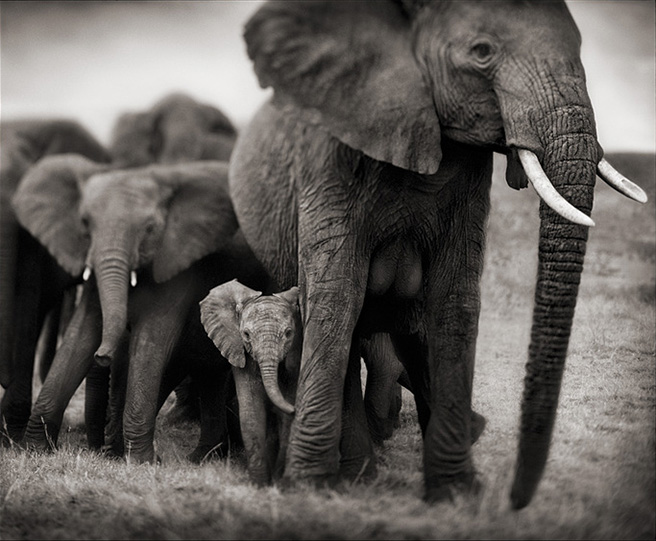The Little Ones
“I hold that the more helpless a creature, the more entitled it is to protection by man from the cruelty of man...”
-Mahatma Gandhi
The above picture was taken by wildlife photographer Nick Brandt (Big Life Foundation), who, one year ago, photographed this elephant just 24 hours before she was brutally slaughtered by gun toting poachers for her ivory.
The elephant, Qumquat, had been studied by researchers for over four decades as she became the majestic matriarch and leader of her "Q" family, keeping them safe for over 40 years. And in one day she and her family were annihilated. Her tiny newborn elephant was orphaned, its mother and family gunned down to serve the ivory trade—its life support gone; any survivors fleeing in terror; its fate: now suffering and death in hopeless and lonely isolation it cannot understand. Fortunately, her infant Quanza was spared and rescued by The David Sheldrick Wildlife Trust, where she is now safe at their nursery. But Quanza is only one of a very few lucky ones. Most do not share this fate.
Adult elephants are attractive to poachers due to their established tusks. 100 elephants are murdered for their tusks EVERY DAY (over 36,000 a year)! Immature elephants do not offer a source of ivory, as their tusks only break through when they are approximately one year old. Like humans, elephants are not born with their teeth ‹ elephant tusks are actually their incisors.
What this means is that numerous young elephants like Quanza are left orphaned when their mothers are killed as victims of the ivory trade. Elephants that are under two years of age require their mothers for feeding, for protection, for learning, and most of all, for affection, just as a human child would. Many, even when rescued, will succumb to grief over the loss of their mother and family members and parish. This is why we must allocate protected natural habitat in countries where elephants and other wildlife can thrive.
More than 75% of elephant range lies totally outside the protected area network, and in many countries there are more elephants outside the protected area network than there are inside.
African Wildlife Foundation works with people on all levels—from governments to individuals in villages—to set land aside specifically for wildlife use, and in some cases, purchase land to set it aside for conservation.
In Zambia, for example, AWF is working with communities in the Sekute Chiefdom to create the Sekute Conservation Area so that elephants can move safely and freely. In exchange for leaving land open for wildlife, AWF rebuilt the Lupani School.
Elephants have no place to run and no place to hide, they are quite literally, sitting ducks, just waiting to be slaughtered and they are running out of space and time. Before we know it they will be gone—unless we collectively stop the senseless poaching and consumer demand for ivory.
Help AWF in doing this by donating today. For the elephants and for their little ones that are in incredible need of our protection, more so now than ever.
For more information on photographer and conservationist Nick Brandt’s Big Life Foundation go to https://biglife.org.
100 percent of the proceeds from Nick Brandt’s prints go to Big Life efforts.

